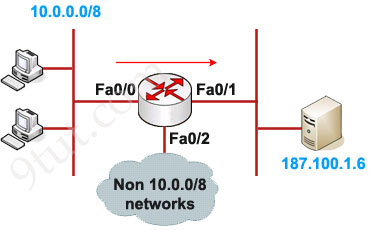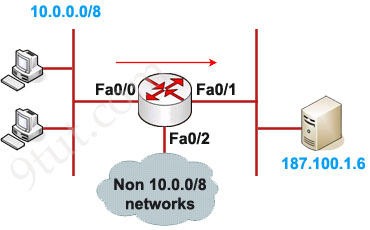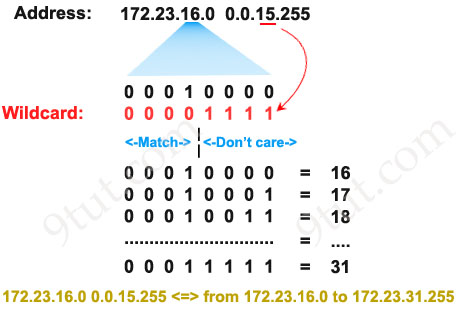In this tutorial we will learn about access list.
Access control lists (ACLs) provide a means to filter packets by allowing a user to permit or deny IP packets from crossing specified interfaces. Just imagine you come to a fair and see the guardian checking tickets. He only allows people with suitable tickets to enter. Well, an access list’s function is same as that guardian.
Access lists filter network traffic by controlling whether packets are forwarded or blocked at the router’s interfaces based on the criteria you specified within the access list.
To use ACLs, the system administrator must first configure ACLs and then apply them to specific interfaces. There are 3 popular types of ACL: Standard, Extended and Named ACLs.
Standard IP Access List
Standard IP lists (1-99) only check source addresses of all IP packets.
Configuration Syntax
| access-list access-list-number {permit | deny} source {source-mask} |
Apply ACL to an interface
| ip access-group access-list-number {in | out} |
Example of Standard IP Access List

Configuration:
In this example we will define a standard access list that will only allow network 10.0.0.0/8 to access the server (located on the Fa0/1 interface)
Define which source is allowed to pass:
Router(config)#access-list 1 permit 10.0.0.0 0.255.255.255
(there is always an implicit deny all other traffic at the end of each ACL so we don’t need to define forbidden traffic)
Apply this ACL to an interface:
Router(config)#interface Fa0/1
Router(config-if)#ip access-group 1 out
The ACL 1 is applied to permit only packets from 10.0.0.0/8 to go out of Fa0/1 interface while deny all other traffic. So can we apply this ACL to other interface, Fa0/2 for example? Well we can but shouldn’t do it because users can access to the server from other interface (s0 interface, for example). So we can understand why an standard access list should be applied close to the destination.
Note: The “0.255.255.255″ is the wildcard mask part of network “10.0.0.0″. We will learn how to use wildcard mask later.
Extended IP Access List
Extended IP lists (100-199) check both source and destination addresses, specific UDP/TCP/IP protocols, and destination ports.
Configuration Syntax
| access-list access-list-number {permit | deny} protocol source {source-mask} destination {destination-mask} [eq destination-port] |
Example of Extended IP Access List

In this example we will create an extended ACL that will deny FTP traffic from network 10.0.0.0/8 but allow other traffic to go through.
Note: FTP uses TCP on port 20 & 21.
Define which protocol, source, destination and port are denied:
Router(config)#access-list 101 deny tcp 10.0.0.0 0.255.255.255 187.100.1.6 0.0.0.0 eq 21
Router(config)#access-list 101 deny tcp 10.0.0.0 0.255.255.255 187.100.1.6 0.0.0.0 eq 20
Router(config)#access-list 101 permit ip any any
Apply this ACL to an interface:
Router(config)#interface Fa0/1
Router(config-if)#ip access-group 101 out
Notice that we have to explicit allow other traffic (access-list 101 permit ip any any) as there is an “deny all” command at the end of each ACL.
As we can see, the destination of above access list is “187.100.1.6 0.0.0.0″ which specifies a host. We can use “host 187.100.1.6″ instead. We will discuss wildcard mask later.
In summary, below is the range of standard and extended access list
| Access list type | Range |
| Standard | 1-99, 1300-1999 |
| Extended | 100-199, 2000-2699 |
Named IP Access List
This allows standard and extended ACLs to be given names instead of numbers
Named IP Access List Configuration Syntax
| ip access-list {standard | extended} {name | number} |
Example of Named IP Access List
This is an example of the use of a named ACL in order to block all traffic except the Telnet connection from host 10.0.0.1/8 to host 187.100.1.6.

Define the ACL:
Router(config)#ip access-list extended in_to_out permit tcp host 10.0.0.1 host 187.100.1.6 eq telnet
(notice that we can use ‘telnet’ instead of port 23)
Apply this ACL to an interface:
Router(config)#interface Fa0/0
Router(config-if)#ip access-group in_to_out in
Where to place access list?
Standard IP access list should be placed close to destination.
Extended IP access lists should be placed close to the source.
How many access lists can be used?
You can have one access-list per protocol, per direction and per interface. For example, you can not have two access lists on the inbound direction of Fa0/0 interface. However you can have one inbound and one outbound access list applied on Fa0/0.
How to use the wildcard mask?
Wildcard masks are used with access lists to specify a host, network or part of a network.
The zeros and ones in a wildcard determine whether the corresponding bits in the IP address should be checked or ignored for ACL purposes. For example, we want to create a standard ACL which will only allow network 172.23.16.0/28 to pass through. We need to write an ACL, something like this:
access-list 1 permit 172.23.16.0 255.255.240.0
Of course we can’t write subnet mask in an ACL, we must convert it into wildcard mask by converting all bits 0 to 1 & all bits 1 to 0.
255 = 1111 1111 -> convert into 0000 0000
240 = 1111 0000 -> convert into 0000 1111
0 = 0000 0000 -> convert into 1111 1111
Therefore 255.255.240.0 can be written in wildcard mask as 00000000.00000000.00001111.11111111 = 0.0.15.255
Remember, for the wildcard mask, 1′s are I DON’T CARE, and 0′s are I CARE. Now let’s analyze our wildcard mask.
Two first octets are all 0′s meaning that we care about the network 172.23.x.x. The third octet, 15 (0000 1111 in binary), means that we care about first 4 bits but don’t care about last 4 bits so we allow the third octet in the form of 0001xxxx (minimum:00010000 = 16 ; maximum: 0001111 = 31).

The fourth octet is 255 (all 1 bits) that means I don’t care.
Therefore network 172.23.16.0 0.0.15.255 ranges from 172.23.16.0 to 172.23.31.255.
Some additional examples:
+ Block TCP packets on port 30 from any source to any destination:
Router(config)#access-list 101 deny tcp any any eq 30
+ Permit any IP packets in network 192.23.130.128 with subnet mask 255.255.255.248 to any network:
Router(config)#access-list 101 permit ip 192.23.130.128 0.0.0.7 any
Apply the access control list to an interface:
Router(config)#interface fastEthernet0/0
Router(config-if)#ip access-group 101 in
No comments:
Post a Comment